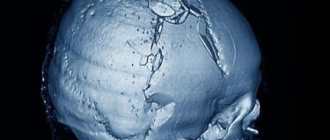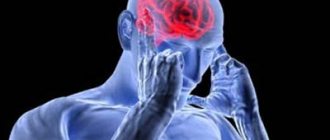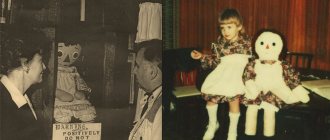- Causes
- Symptoms
- In adults
- In children
- Possible consequences
- Heart attack
- Stuttering
- Danger for pregnant women
- Medicines
- Traditional methods
- Working with a psychologist
- Help from a speech therapist
Anything can cause horror in a person: a sharp sound, a loud emotion, an unexpected action. Severe fear is instant fear provoked by some irritant.
Features of the problem
In order to choose ways to get rid of a problem, it is important to understand what it is. Severe fright (shock neurosis) is a sudden, instant fear that is caused by a serious irritant. This reaction is a combination of an orientation reflex and fear. After a shock, a person experiences psychosomatic disorders.
A state of severe fear is most often experienced by young children. A similar problem is typical for children who lag behind their peers in development.
Manifestation in children
Any person becomes lost when frightened, as he falls into an atypical state. Among the typical manifestations of cowardice in children are:
- crying and shaking at night;
- lack of sleep;
- irritability and nervousness;
- depression and depression;
- stuttering;
- rapid pulse;
- high blood pressure.
If a child has such symptoms, you should contact a child psychiatrist. Ignoring the problem can lead to serious consequences. Children, numb with fear, cannot cope with the problem on their own; they need help from adults. In some cases, the disease is accompanied by severe headaches, which must be responded to immediately.
Severe fear, left unattended by parents, can lead to problems communicating with peers and adults. Because of the fear of being in a stressful situation again, the child will strive for complete isolation.
Causes of fear
Because of differences in life experiences, adults and children are afraid of different things. For example, if for us the squeal of brakes is a harbinger of an accident, then for a child it is only a loud sound. In such a situation, an adult will tense up, look around, and try to go to a safe place. And the baby will show maximum curiosity and look towards the source of the sound.
At the same time, children can be frightened by completely trivial things. For example, a dove flying overhead or a clown at a party.
What else can scare a child:
- Loud sounds that arose abruptly: a hammer drill, a scream, the roar of thunder, a dog barking.
- Scary pictures, exotic animals, people with unusual appearance.
- Doctors and medical procedures if the child has a negative experience.
- Stressful situations: moving, separation from parents.
- Emergency incidents: animal bite, falling from a slide or bicycle, physical violence.
Typical symptoms
Severe fear in an adult is similar to the symptoms that appear in children. Among the main signs:
- sleep disturbance;
- coughing;
- increased heart rate;
- stuttering;
- paralytic stupor.
Why does a person’s heart beat so fast when they are frightened that they start screaming? The reason is severe emotional shock. The nervous system reacts to an external stimulus. That is why people, numb with fear, after a while, begin to scream loudly.
Fear not only kills the mind... it is quite capable of killing the body too. Death by fright may seem like a myth, but it really happens to people—and animals. The authors of Zoobiquity: What Animals Can Teach Us About the Health And Science of Healing examine this issue in detail. So what really happens to those who are scared to death? The number of heart attacks increases during earthquakes, financial disasters and civil unrest. They also often happen during extra time at football matches... and while watching horror films. They occur in people and animals, and not physically injured ones. Our bodies are designed in such a way that we can literally be scared to death. Mechanism There are several ways fear and stress can stretch, tear, or break a heart. The heart is a collection of chambers surrounded by muscles that support and compress them, forcing blood through them. There is a well-known syndrome that disrupts the balance between the chambers and muscles. Japanese doctors have noticed that relatively young and healthy people who are under constant stress, pain or fear may develop symptoms of a heart attack. Having looked closely at the heart of one of the patients, they saw that one of its chambers was noticeably swollen. Someone in their place might have thought it looked like an eggplant or a light bulb, but they saw it as a takotsubo - an octopus trap used by Japanese fishermen - and called the syndrome "takotsubo cardiomyopathy." The nervous system controls the rhythm of contractions of the heart muscle. Stress hormones - catecholamines - are, in principle, supposed to increase the capabilities of muscles, causing them to work harder and faster than usual, and to respond better to nerve impulses. Sudden shocks—whether simple fear or deep emotional stress—cause a release of hormones that disrupt the heart rhythm, increase tension on certain parts of the arteries and muscles, or completely poison the muscles. Most patients with Takotsubo syndrome recover. In some cases, however, the normal heart rhythm was so disrupted that people died. Sometimes the ventricle literally burst. This circumstance, combined with the emotional background of the disease, led to Takotsubo cardiomyopathy being called “Broken Heart Syndrome.” However, stress and trauma don't just kill the heart. Catecholamines burn all the muscles in the body. They cause muscles to literally burn and break down. This is especially true for skeletal muscles—the muscles associated with the skeletal system. When these muscles are destroyed, proteins from them enter the blood, and from it into the kidneys. The kidneys eventually cannot stand it and fail, the body is poisoned and death follows. This process is called, not so poetically, rhabdomyolysis. Sometimes it happens unexpectedly, but more often - as a result of a long chase, with constant muscle tension and emotional exhaustion. Deaths Deaths from takutsobu syndrome come as no surprise to one segment of the medical world: veterinarians, who have been dealing with the deaths of freshly caught animals since their profession began. This phenomenon is called catch myopathy. The mortality rate among captured wild animals ranges from 1% to 10%. For some species, including most birds, it can be up to 50%. Since the focus shifted from hunting to conservation, techniques have been developed to reduce mortality. These include limiting mobility as little as possible, not following the animal, minimizing noise and traffic, and allowing the animal some space to move. It is also believed that one should not look directly into the eyes of a captured animal for a long time. If animals do not die upon capture, these factors help reduce mortality. They also help reduce mortality in captivity. Zoos know that animals need a lot of space, they need places to hide from visitors, and that noise must be reduced at all costs. There is a known case where an opera performance in a nearby park scared an okapi to death. Another zoo learned that some animals are better off not being kept together when several zebras died while they were housed in the same enclosure as an African buffalo. People die unexpectedly in the same way as animals frightened by a loud noise or carelessly caught - although usually under different circumstances. Strong shocks sometimes kill seemingly healthy people. The curse of humanity is that our emotions make us feel in some situations like a zebra caught in an enclosure with a large and dangerous animal. Financial collapse, the death of a loved one, the inability to get rid of a phobia causing factor, bullying at school or at work cause the same physical reaction that occurs in animals when their life is threatened and there is no hope of escape from it. People who feel trapped are at risk of the same “capture myopathy” as trapped animals. The body releases the same cocktail of chemicals. It gives energy to muscles in the short term, but in the long term or when overloaded, it simply destroys them. The stress continues without respite, and the body seems to fail. A person can literally be scared to death. The connection between these two diseases was first traced by Barbara Natterson-Horowitz, a surgeon who worked with both humans and zoo animals. Both experienced the same physical injuries stemming from the same emotional sources. It seems that animals and I have more in common in our emotional and physical responses than we think. For more information on this and other health issues common to humans and animals, see Barbara Natterson-Horowitz and Kathryn Bowers' book Zoobiquitousness: What Animals Can Teach Us About Health and the Science of Healing.
InoSMI materials contain assessments exclusively of foreign media and do not reflect the position of the InoSMI editorial staff.
Consequences
Before choosing a treatment option, it is necessary to find out the main causes of fear and its possible consequences. Since the disease is considered psychological, the results can be quite serious. The reaction to fear depends on the individuality of the person’s psyche. Sensitive people, as well as people with heart disease, can experience serious health consequences as a result of fright.
In childhood, the following consequences are possible: isolation, loss or delay of speech. In adults, this condition can even lead to death. If you are very scared, what should you do?
It is impossible to prevent such a disease, but it can be treated. Some believe that fear can cause a heart attack. For a healthy person, such consequences are not typical. His blood pressure rises and his heart rate increases. In people with diseases of the cardiovascular system, a sharp release of adrenaline provokes a myocardial infarction, and subsequent rupture of the middle wall of the heart is possible.
A lethal outcome is possible only when an attack of fear coincides with a heart attack. The results of statistical studies indicate that only 5% die as a result of heart failure. What are the main symptoms of this problem? A person falls, loses consciousness, the veins in the neck thicken (swell) and a gray-blue color appears in the upper part of the body.
How do parents feel?
The first emotion that a mother of a frightened child encounters is confusion. In the first seconds, it may be difficult for her to navigate and determine the so-called “amount of damage.” Therefore, in such a situation, one can understand the child’s confusion or delayed reaction to the source of stress.
After a minute, the understanding comes that the baby was very scared. And here it is important to behave correctly:
- try to calm the child down with words;
- support tactilely - hug, caress, kiss;
- switch his attention to something neutral (give him a toy);
- leave the place where it happened;
- monitor the condition of the baby at home;
- be prepared for the consequences of fright.
Not all parents realize the degree of influence of stress on the child’s psyche. Therefore, some may deny the presence of fear, while others may associate any disturbances in the child’s behavior or well-being with it. Still, it’s better to stick to the golden mean: don’t ignore what happened, but don’t attribute all the problems to fear.
Also important:
- do not shout at a frightened child;
- do not shame him, do not force him to calm down;
- do not engage in active games immediately after a stressful situation.
Stuttering
Sudden fear (severe stress) causes emotional shock and leads to disruption of the functioning of the speech apparatus. Stuttering and loss of speech are symptoms that are typical for preschoolers and children of primary school age. Among the reasons, psychologists note the unfair attitude of adults towards children. Due to speech disorders, the child refuses to communicate with peers.
How to treat fear? Experts recommend that parents, when they detect the first symptoms of a problem, immediately contact specialists. A neurologist and speech therapist will select a comprehensive individual program for getting rid of speech defects. Eliminating stuttering is a long process.
Correction of the problem is carried out through respiratory therapy, development of the articulation and voice department. Psychological assistance helps to increase the child’s self-esteem, so it is also included in the complex of restorative measures. To achieve a positive result, it is important that the patient is in a state of emotional balance.
Fright during pregnancy
Some people believe that there is a fetal scare. The fears of a pregnant woman are automatically transferred to the baby. Is it really? Medical professionals recommend that expectant mothers protect themselves from negative emotional upheavals.
Fear provokes an increase in blood pressure, which can stimulate placental abruption and negatively affect the child.
The danger of intrauterine fright has been confirmed by numerous studies. After birth, the child becomes withdrawn and suffers from autism. Doctors advise pregnant women to take natural sedatives: motherwort, valerian.
Folk remedies
Homeopathy helps fight mild forms of fear. It is important to select a drug taking into account the individual characteristics of the body, as well as the severity of the shock.
Shock scares can be treated with arnica. Belladonna is recommended for seizures. St. John's wort perfectly eliminates the effects of shock. Virginia jasmine is used for emotional fears in children.
Opium is prescribed in case of enuresis, fear, accompanied by dizziness. Black herb (elderberry) is useful for nervous people. White arsenic oxide is used for nightmares and fear of death.
Treatment options
Treatment begins with the prescription of medications that are needed to calm the patient. After that, work is carried out with a psychologist, neurologist. If there are signs of stuttering, contact a speech therapist. If prescribed by a doctor, you can try traditional methods, but do it yourself, i.e. self-medication is prohibited.
Medicines
Initially, your doctor may prescribe medication. Its goal is to eliminate depression or anxiety. Sedatives are suitable for this.
5 best drugs that have a sedative effect:
- "Fitosed";
- "Persen Forte";
- "Novopassit";
- "Dormiplant";
- "Algoven Relax".
Neuroleptics, which have an antipsychotic effect, are also suitable for treatment. They reduce impulse transmission, eliminate the gag reflex and abdominal cramps. The best among them: Aminazine, Triftazine and Haloperidol. Neuroleptics are taken in small doses.
Another effective drug is tranquilizers. These are remedies that relieve anxiety and the feeling of fear. Eliminate emotional stress, help reduce obsession, i.e. the number of depressive obsessive thoughts that are almost completely removed.
Tranquilizers relieve a person of severe chills and muscle weakness. Improves the general condition of the frightened person. Tranquilizers also have anxiolytic, hypnotic, muscle relaxant and anticonvulsant effects.
TOP 8 best tranquilizers:
- Midazolam;
- Benactizine;
- Mebicar;
- Phenibut;
- Gidazepam;
- Diazepam;
- Atarax;
- Afobazol.
Plant-based sedatives help a lot. They contain valerian, St. John's wort, medicinal chamomile, motherwort, etc. They are the most harmless among sedative drugs and can be prescribed to small children.
Traditional methods
In cases of severe fear, conspiracies help. The most popular is pouring wax into water. This will help a person cleanse his energy.
The frightened man is seated in the center of the room. Pre-heat 500 g of wax, which is poured into a container of water. During the process, a prayer is read, and a plate with wax is held above the head. A person will feel relief only after 57 days.
Another popular method is homeopathy. This is a type of alternative medicine that involves the use of highly concentrated decoctions or preparations based on mixtures of plants. The following herbs are often used:
- arnica is needed to treat fright resulting from a blow;
- belladonna is used for seizures;
- Virginia jasmine helps to cope with hysteria during emotional fears in children;
- St. John's wort is effective in cases of shock;
- opium is prescribed for severe dizziness, which occurs as a result of enuresis, fright or an accident;
- black herb is prescribed for very nervous and timid people who are afraid of another person;
- White arsenic oxide is used for fear of death and nightmares.
Working with a psychologist
After experiencing a strong fright, a person often experiences mental disorders. He becomes nervous, irritable, and has sudden mood swings. Working with a psychologist will help you cope with this. There are 3 main methods of treatment: hypnosis, cognitive behavioral therapy and art therapy (prescribed for children under 15 years of age).
Hypnosis
Only classical or hypnosuggestive hypnosis will help. Its main characteristics:
- commands are pronounced clearly, in a menacing voice, in a raised voice;
- the patient does not have the opportunity to choose or reject suggestions, he can only succumb to the influence of the hypnologist;
- entry and exit from trance are abrupt;
- the effectiveness of treatment is high.
First, the patient is asked to close his eyelids to make him feel confused and temporarily fall asleep. This will allow you to work with him at the subconscious level. New patterns of behavior are instilled that completely contradict those formed as a result of the fright. Also in the process, the client’s energy balance is restored.
Cognitive behavioral therapy
First, the patient is examined for possible reasons for the development of mental disorders as a result of severe fright. This is done using leading queries. The patient is asked to tell:
- what or whom I was afraid of;
- how I felt;
- how the fright occurred;
- how I felt after the incident;
- whether others talked about any negative changes in my behavior.
But in addition to individual sessions, the patient is given homework. They are more important because they have a greater influence on human behavior. Directly depend on the consequences of severe fright.
An average course of cognitive behavioral therapy consists of 56 procedures. If the client is a child in adolescence, the number of sessions can increase to 8. 1 session lasts about 4060 minutes.
Art therapy
The most effective method for relieving the signs and consequences of mental disorders or disorders in children under 12-15 years of age. The child perceives it as an ordinary game, and not a way to treat a disease.
The child is asked to depict with the help of a drawing, dance, song, poem, or theatrical performance what frightened him. Most often, patients choose art.
After this, the doctor carefully analyzes the drawing, examines all the strokes, lines, ornaments, patterns. Pays attention to what colors the baby used in the drawing.
Next, the patient is asked to destroy the drawn image in any way, tear it up, trample on it, pour water on it, throw it in a trash bin, etc. The problem needs to be let go.
Help from a speech therapist
If, as a result of severe fright, a person has problems with speech, you need not only to contact a psychologist, but also make an appointment with a speech therapist and neurologist. Such a comprehensive treatment will help you quickly get rid of the problem.
The process of eliminating speech defects takes at least 3 months of regular classes. In children, treatment can last six months.
Correction occurs using breathing techniques. Next, the vocal and articulatory departments are developed.
The main requirement when visiting a doctor is that the patient must be in a calm emotional state. Otherwise, the probability of a quick cure tends to zero.







